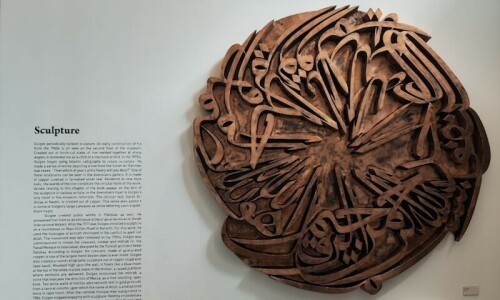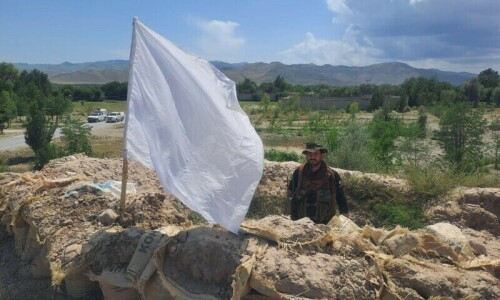“That constellation is the Big Bear, the one opposite it is the Little Bear. At the tail end of the Little Bear is Polaris, the North Star,” I was told. I was around 15 years old when one clear night up in the Northern Areas my father, a sailor, pointed to the sky and showed me how to use the stars to navigate.
The constellation he showed me, Ursa Minor (Little Bear), has historically been very important for mariners making their way through the deep seas. That’s when I realised that the stars above us aren’t just pretty sparkly things but rather altogether form a map. And much like a book, it can be read.
It would take another 15 years before a group of amateur astronomers would teach a bunch of us how to read parts of that map and the secrets it held. Last weekend, the Karachi Astronomers Society organised one of their much-awaited overnight stargazing trips.
The location: the mud volcanoes in the Hingol National Park in Balochistan. They are a four-hour drive from Karachi on the Makran Coastal Highway. The drive itself is beautiful; there is a moment when you go from having the sea on your left to suddenly being confronted with the small but wild and mostly desolate mountain ranges of Balochistan.
Far from the maddening crowd and ‘light pollution’ of urban settlements, the remote mud volcanoes in Balochistan provide the perfect setting for a night of serious stargazing
[Makran Coastal Highway road trip pro-tip: the best bathrooms are at the checkpoints, not the roadside dhabas.]

The location is remote enough for it to get completely dark so even those stars that aren’t visible from the city can be seen. And with the nearest checkpoint a few hundred metres away, it’s completely safe.
The area looks dry and barren, and has a lunar landscape. And while the last hours of daylight can be spent setting up camp and figuring out the toilet situation (there are none), the location affords you a whole new adventure: climbing one of the mud volcanoes.
It takes about 20 minutes to get to the top, depending on how fit you are, the climb is quite steep and the terrain smooth in places where the clay has hardened. Because the area is popular with Hindu pilgrims for whom the volcanoes are holy, you may find incense sticks on the top and at the foot of the volcano. There may also be some poles stuck throughout the length guiding you to the summit.
We were camped at the foot of the largest volcano, Chandragup. It’s still active. Early in the morning, we could see a trail of fresh muddy clay seeping down one end of it.
At nightfall the astronomers and astro-photographers started setting up their precious telescopes and camera stands. The night was spent stargazing from the naked eye and through the telescopes, listening to lectures by the astronomers, and engaging in heated (and very nerdy) discussions. Yes, this is an event where your typical nerds and science geeks are the heroes. So don’t be afraid to get your geek on.

There was no meteor shower that night, although we spotted quite a few shooting stars — my friend counted 16 that he saw. But that night was still special, according to amateur-astronomer-by-night and computer-programmer-by-day, Abubaker Shekhani, one of the founders of the Karachi Astronomers Society. “The most important thing is the Sagittarius arm of the Milky Way, which is also known as its ‘summer arm’,” he told me. “This is the last opportunity to view it from our skies as it will now be invisible next year.”
What we thought was a very bright star that came out at twilight turned out to be the planet Venus — visible at this time of the year with the naked eye. Through the telescope we were shown Mars and Saturn, its rings a bit blurry but distinct.
I finally observed a ‘nebula’ (a cloud of gas and dust in space) and few were identified to me: Lagoon, Ring and Orion Nebulas. In the constellations we spotted Sagittarius, Taurus, Pegasus, Perseus and, what I thought was, Gemini.
We saw the Andromeda Galaxy, which according to renowned astrophysicist Professor Brian Cox is our “galactic neighbour”, the nearest galaxy to the Earth and visible with the naked eye. As luck would have it, we also got to see the Triangulum Galaxy. Apparently it’s not easy to spot precisely and see through the telescope. It also turns out that the galaxies are all white. They’re not pink, purple and blue as they appear in colour-enhanced photos in textbooks and on the internet.

We saw a few star clusters as well. There was the Double Cluster, the Beehive Cluster, and my favourite, Pleiades or the Seven Sisters. In ancient Greek mythology, the Pleiades were the seven daughters of the titan Atlas and sea-nymph Pleione.
The name of the star cluster Pleiades came before the myth. It derives from the word plein (to sail) because of the cluster’s importance in marking the sailing season in the Mediterranean — the season of navigation begins with their heliacal rising. Heliacal rising is the day a star (or a cluster) is first visible above the eastern horizon for a brief moment just before sunrise.
Eventually, we snuggled into our respective sleeping bags, facing east so as to catch the rising constellations at different parts of the night and the sunrise at dawn.
Looking up at the stars, you can’t help but wonder how small and insignificant you are. These stars are billions of years old, the distances between them in the millions of light years.
We don’t come close to comparing to even a tiny fraction of their very existence. You are confronted by this infinite vastness and it’s a little scary, but also humbling.
“I can’t help but realise how unimportant and silly our problems are,” said my friend, “and how none of them really matter.” I agreed.




Published in Dawn, Sunday Magazine, October 9th, 2016
Have you traveled to any remote locations around the world? Share your experience with us at blog@dawn.com

















































